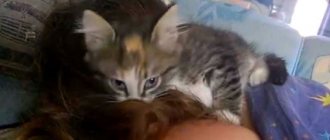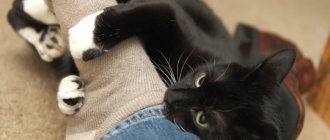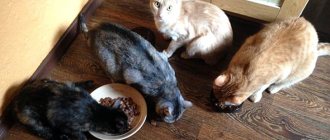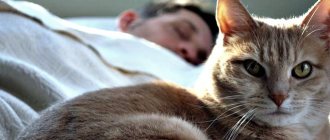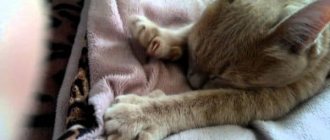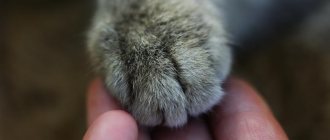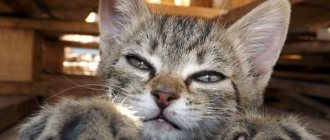Manifestations of cat love
Contrary to the popular belief that cats are attached exclusively to the house and live with people for their own benefit, these animals, despite their independent nature, feel the need for love, attention and affection. Cats are smart, noble creatures, and if you treat them properly, create the most comfortable conditions, surround them with affection and warmth, they will definitely reciprocate. The affectionate cat's soul is capable of strong friendship with the owner and members of his family. But how can you tell that a cat loves its owner?
We suggest you read: Why does a cat sneeze often, what to do and how to treat it
You can determine a cat's love and sympathy by the behavior and habits of your pet. From the first days of a kitten’s appearance in the house, it is very important to establish contact with the animal and create the most favorable, comfortable environment. Finding itself in an unusual, unfamiliar place, a kitten or an adult animal will be disoriented and will try to adapt to new conditions through hearing and smell.
During the adaptation period, an animal can be tamed only with a friendly attitude and care. The cat should feel completely safe. Representatives of the cat family are straightforward and frank, and cannot tolerate disrespectful or rude treatment. To win their sympathy, you need to earn the cat's trust.
Undoubtedly, hiccup cats are capable of loving their owner, but they show their feelings in their own way. There are several signs by which you can determine a cat's friendship and favor. Some manifestations of cat love are obvious, while other signs of sympathy, on the contrary, may be implicit.
To find out whether cats love their owner, you need to carefully monitor your pet and study the animal’s body language. It serves to express a whole range of feline emotions. Pay attention to what sounds the cat makes and how it behaves in a given situation. By meowing, she can attract attention, demonstrate anxiety, and the need for affection.
Signs that help you understand whether cats love their owners include:
- purring, loud purring;
- gentle biting, head butting;
- tail twitching;
- attempts to bring their “prey”, toys;
- “stomping” during rumbling;
- cat kisses, licking hands, faces;
- blinking, long, peaceful look;
- permission to rub the tummy;
- sleep next to the owner.
Are cats bored without you or are they having fun?
They say that cats behave like children in the absence of their owner. They climb into exactly those places where they are forbidden to climb in the presence of an adult. They are primarily interested in those things that are strictly forbidden to touch. Therefore, after returning home, adults often find the same mess both after the cats and after their beloved children spent time on their own.
Returning home, you can find complete chaos and disorder, which consists of things and cereals thrown out of cupboards, broken dishes and tattered books. One can only guess how these furry creatures behaved in our absence.
The kindest and most patient owners regard this mess as fair revenge on the owners from their pets for their long absence. After all, they don’t organize such a pogrom in front of them. But there is a situation when an urgent departure, which seemed not to be part of our plans, is inevitable.
Lays on your clothes
It's all about the smell again, they just like your smell, for them it is a symbol of safety and comfort. And this is also one of the options for how cats show love for their owner - they strive to appropriate his smell, and at the same time gift things with their own. This way, at the moment of separation, the owner will not forget about his cat, and other animals will know that the person is already busy.
Cat tenderness
If a cat rubs its muzzle against your legs, arms or face, this does not mean at all that the animal is “marking” its owner as property. On the head of cats there are secretory glands that secrete special substances that allow them to leave their scent on well-studied objects and people that do not pose a danger.
We suggest you read: Do cats understand human speech: simple ways to communicate with your pet
If a cat licks exposed parts of the body, rubs its whiskers on its hands and face, this is the highest degree of manifestation of cat love and devotion. Stroking a person with a paw is a sign of affection and tenderness. If a furry pet rolls from side to side at your feet, exposing its tummy, this indicates that the animal wants to attract attention, completely trusting you.
If a cat doesn’t trust a person, he will never let you touch his tail and will definitely grab your hand. A cat's tail is a kind of mood barometer. And if the cat follows you with its tail raised like a pipe, this means that it invites you to dialogue, demanding attention.
A sure sign of cat affection is “stomping,” shifting from paw to paw with claws extended. This habit begins in childhood, when babies stimulate the flow of milk. Adult animals thus show that they feel completely safe, they feel very good with their owner, just as they once did with their own mother.
Rubbing on your legs
Tailed friends often rub their entire bodies against the legs of their owners. This is how the cat leaves its scent and, as it were, says: “Hello, how are you?” This is a real ritual for cats. What’s important is that a cat will never rub against the feet of someone it doesn’t trust, because such a person is not worthy of wearing its scent. By the way, with such behavior, cats not only show their love for their owner: they have noticed that some animals do the same actions towards guests entering the house. This is usually what cats do, considering themselves masters of the territory. They definitely need to “tag” the guest, but the message here is already changing and sounds something like this: “You came to my house, now you are mine.”
Naivety of people
Very often people perceive a cat as a very gentle and affectionate animal. This is wrong. If the owner wants a faithful friend, he needs to take a dog; it is much more distant from its wild ancestors than cats. No, this does not mean at all that you should not take cats into your home, especially homeless ones. You just need to immediately understand that these animals will not fully look into a person’s eyes with love. Yes, they are devoted to a specific house, since most often they consider it their territory. They are good to play with, and the purring of a kitten is the best antidepressant. But if such a “lump” goes to the neighbors or just for a walk, you shouldn’t tear your hair out, the cat just always remains free.
Brings loot
What do we do for our loved ones? That's right, we give gifts. And cats also express their love for their owners with this amazing act. Often cats, having caught a bird or a mouse, and sometimes some leaf, proudly carry the trophy into the house and place it at the owner’s feet (on the threshold, on a pillow, etc., depending on your luck). Of course, they go after prey not out of hunger, but to satisfy their hunting instinct. But why bring the spoils into the house?
According to some, this is how a cat thanks a person for feeding him, others believe that this is a manifestation of love and care. Animal psychologists claim that by sharing a trophy, a cat reproduces the behavior pattern in a cat family, where some hunt, while others raise offspring, and he perceives a person as his own kind. Be that as it may, whether it is gratitude, a show of care or “patronage,” the cat brings its prey to you. It means you are a special person for him. Such gifts are undoubtedly a manifestation of the cats’ love for their owner.
Joint gatherings
A cat, like any other animal, must have its own space and territory where it can retire to sleep or rest. But a sense of comfort is not the only motive that drives pets. Sometimes an animal, in need of attention, is ready to sit and even lie in an uncomfortable position just to be close to its beloved owner. If your cat chooses a place to rest next to you and tries to climb onto your lap, rest assured, this is another way of showing her love.
Everyone knows that cats sleep most of the day and can spend up to 20 hours sleeping. But it is in their sleep that they feel most vulnerable, so they prefer to rest in the safest places. If the cat lies down at the feet, next to the owner, this indicates complete trust. This means that the animal feels completely safe with you.
Quotes about your favorite cat
It seems that the only one who understands what is inside me is my cat. When I take him in my arms, he looks as if he understood everything.
I’m sitting, having nothing better to do, imitating my cat. He will lick his lips, I will lick my lips. He yawns, I yawn. So he, the bastard, twisted around and started licking the balls.
A cat person is when you carefully cover the burden that weighs you down at night and don’t move so as not to disturb it.
My beloved cat always stays on my lap until the last moment when I get up. Waiting for me to come to my senses, I’m a shameless person
My kitten is an optimist: he eats food for adult dogs of large breeds!
My Barsik is the cutest, affectionate and loving pet. When you're hungry.
Only people with pets are not afraid of the crisis. There will always be money for food.
I am completely sure that my cat has a soul. Otherwise she would not have such piercing and understanding eyes.
The best Mafia players are cats. When the city falls asleep, my Barsik wakes up.
Night. It's 2 o'clock in the morning. I wake up to the wild scream of a cat. It turned out that this dunce got into the duvet cover and got lost there! I had to save him.
My best friend doesn't tell anyone what I eat at night. He does this to me. Thank you, Barsik.
I think our relationship with the cat reached a new level when he started drinking from my cup.
HOW CATS RECOGNIZE THEIR OWNERS.
In most cases, she will not respond, she will not even deign to turn her head. But doesn't she respond to your call? But what about the barely noticeable movement of the ears or a momentary slowdown in step?
It's probably harder to love a cat than a dog. A dog's devotion is clearly expressed, and this captivates a person. But it is a mistake to think that a cat “walks on its own” in every sense of the expression. A cat actually walks completely differently from a dog (whoever has walked a cat on a harness knows that the cat walks the owner, and not vice versa). But a cat needs love, care, communication, and attention just as much as a dog. Only this need is expressed in a cat in a specific way. Therefore, a person often turns out to be unable to appreciate and satisfy the need for love of his mustachioed friend. Often, only in extreme circumstances is a person forced to admit that a cat has a strong psycho-emotional dependence on a person: many cats experienced severe stress in cases of separation from the owner or serious illness of the owner, and some (especially older ones) could not stand the separation.
Understanding the mental needs of a cat living in the same household as a person is essential to preventing many behavioral problems.
Try to remember a few simple but extremely important aspects of proper cat training. These rules are based on the fact that a cat is a social animal, but not a pack animal. Cats are capable of living in colonies, but cats hunt and move around the territory alone. (A pack animal is a dog). For a cat there is no unconditional authority of a leader, just as there is an authority of a leader (human) for a dog.
- Don't physically punish your cat. A cat, unlike a dog, does not perceive physical punishment as an incentive to obey. Physical punishment for a cat is only a source of fear.
- The cat does not perceive direct prohibitions. In order to wean a cat from bad habits, the cat needs to be offered an alternative, i.e. you need to negotiate with the cat.
- When making a decision, the cat should always be given the right to choose (whether or not to share a bowl with other animals; whether or not to come into contact with guests, etc.).
In cat colonies, a fairly rigid hierarchy is always established, which sometimes undergoes changes as a result of natural processes in the life of animals. But never try to change the established status of colony members on your own initiative. If you feel pity for a pariah (a cat of the lowest social status), you can provide her with additional affection and care, but never encroach on the established rules (do not feed the pariah where dominant cats feed, do not interfere with ritually aggressive “ performances”, etc.). Your actions, which are contrary to the cat's natural social status, will likely cause great stress to the animal.
The cat is a territorial animal. Cats living in colonies near human habitation, like cats living in a house with a person, retain the need for their own “mini-territory.” Every cat needs a place where it can relax from time to time and be inaccessible to the outside world. Cats living side by side are able to share shelters. Special houses for cats, which are sold in any pet store, serve as an excellent shelter. If it is not possible to purchase such a house, let its role be played by a simple cardboard box located in a secluded place. Not all domestic cats necessarily want to hide. Some people prefer to sit on a cabinet near the ceiling, doze off, or watch what is happening below. The main thing is inaccessibility and isolation. This behavior is typical of many animals that hunt from ambush.
If several cats live in your home, equip your home with horizontal shelves nailed to the wall above human height, or a staircase that extends from floor to ceiling. These simple devices will help your cats avoid forced conflicts over territory and reduce tension in relationships. After all, cats living together constantly communicate, build and sort out relationships among themselves, fight for power, conquer and protect their own territory. In families where two or more cats live, very difficult relationships develop between them, which the owners sometimes do not even suspect. Having a private “mini-territory” is one of the main mental needs of a domestic cat.
What is the key to a healthy psyche in mammals (including humans)? Mother's love and care in early childhood. Never separate a kitten from its mother cat before 8 weeks of age. 8 weeks is the minimum period during which a kitten manages to socialize: learn basic play and hunting skills, learn regular grooming, learn the principles of behavior in cat society (through communication with littermates), and most importantly, gain a sense of security and self-confidence , which means to form a positive attitude towards the world around us. Kittens that have lost their mother too early are characterized by excessive play and hunting aggression, and grow up distrustful, fearful, and emotionally unstable. In the most severe cases, such kittens grow up aggressive (do not confuse aggressiveness as a type of mental constitution with excessive play or hunting aggression).
Of course, human love and care can compensate for early separation from the mother and littermates. After all, in order for a kitten to grow into an aggressive animal, additional unfavorable factors are required (long periods of loneliness, excessive harshness of upbringing, ignoring the needs of the baby, etc.).
The lack of normal playing and hunting skills of a kitten or teenager is often compensated for quite simply - by the presence in the house of another, older cat, which usually takes on the role of teacher in relation to the ill-mannered baby. But the persistent aggressiveness of the character of an adult cat, both in relation to humans and other animals, and in relation to the surrounding world in general, requires a long-term, comprehensive correction program.
Susceptibility to stress, fearfulness, timidity, mistrust - all these are external manifestations of hidden aggressiveness in an adult cat, i.e. Aggression hidden in the depths of the psyche, unfortunately, is practically impossible to correct.
Serving people is a genetically formed basic mental need of a dog. In my opinion, the absence of an owner, “nobody’s”, the inability to realize oneself in serving a person is much worse for a dog than hunger and cold. As for the cat, then, perhaps, not serving a person, but living next to a person, his care, close (or relatively distant - different for different breeds) contact - this is the main mental need for a cat. Thus, “nobody's” is just as evil for a cat as it is for a dog. “Walks on its own” - this should not be understood as the cat’s disinterest in communicating with a person. “By itself” means at a certain distance, within the boundaries of personal space, which a person must be able to respect, but still close to the person just enough to feel the person’s love, the person’s need.
Communication between a cat and a person should begin in the earliest, neonatal period (from birth to 2 weeks) in the form of short, light stroking. Because During the neonatal period, the social activity of kittens is minimal; kittens should not be actively squeezed, unnecessarily disturbed, or constantly pulled out of the nest.
The period of early socialization (3-8 weeks from birth) is called the sensitive period. The sensitive period is the time of mastering social skills, the formation of character traits, intelligence, as well as the beginning of the formation of relationships with a person. Kittens begin to master object play, hunting behavior, and grooming. At this age, it is necessary to provide children with toys. Communication with a person in a sensitive period should be constant and close. At this age, you can begin teaching kittens various commands and getting used to wearing a harness.
The period of late socialization (9-16 weeks) is the peak of the development of social play. At this age, conflicts over status occur between children. At the age of up to 16 weeks, kittens develop their character, their intellectual abilities and physical capabilities rapidly develop. At the end of the period of late socialization, the relationship with the person is finally formed. If kittens do not get used to humans before 16 weeks, it can be very difficult to tame them later.
10-12 weeks - peak climbing on vertical surfaces . At this age, kittens need a variety of posts and vertical surfaces for climbing and claw points. Special educational games have been developed for the mental development of babies aged 9 to 16 weeks. The world's first mental stimulation system for kittens was developed by specialists from the Australian Small Animal Veterinary Association. It is called “training classes for kittens” (kitten classes) and is successfully used in veterinary clinics in Australia, Great Britain, and New Zealand. Training classes for kittens help kittens fully develop their intellectual abilities and socialize properly (especially if the kitten is raised alone). Kittens are brought to classes by their owners, and the classes themselves are supervised by a specialist. During classes, kittens solve various food and hunting problems and learn to play object games together. The most capable ones undergo training at the request of the owner.
Unfortunately, special wonderful mini-puzzles and mini-sports machines developed by ASAVA specialists are not yet available to Russian kittens. But it won’t be difficult to come up with, for example, the simplest food problems on your own. Cut round holes in a shoebox, place the box on the floor, drop a treat into one of the holes, and let your little one try the challenge of getting the treat! It is also not difficult to build a zigzag tunnel from available materials, in the center of which there is something tasty or a moving toy.
The results of kitten training at kitten classes illustrate the need for mental stimulation for the proper mental development of babies; kittens grow up smart, maximally socialized, and most importantly, mental stimulation is the key to reducing stress and aggression.
The need for object games, as well as interactive games with humans, accompanies the cat throughout almost its entire life. So, during adolescence , as well as during the period of maximum social activity (from 1 year to 6 years), it is necessary to diversify the life of a domestic cat as much as possible. After all, very often cats in the confined space of city apartments are forced to lead a monotonous, boring life, which does not contribute to the realization of natural mental abilities. Diversify your cat's life with various toys, climbing surfaces and other necessary items that can brighten up your cat's life. If you are so busy that you cannot pay enough attention to your cat, bring a second cat into the house (the best option is to buy two littermates at once).
A cat is a child of traditions and habits. Even the most minor changes in the current way of life can cause stress in a cat. Feeding at an unspecified time, the arrival of a new person or animal in the house, moving, changing or rearranging furniture, the loss of someone in the household, even the disappearance of a favorite chair - all this can cause stress.
A cat is an animal with a fairly subtle mental organization; the emotional sphere of cats is extremely developed. It is perhaps impossible to achieve a complete absence of stress-forming factors in a cat’s life, but it is important to know which factors are especially destructive for your cat.
Felinologist instructor Elena Sorokina
* when republishing, a link to the site is required
Cat pranks
Sometimes cats can show love in not entirely obvious, veiled ways. For example, if a pet sharpens its claws on upholstered furniture, this does not always mean that it is sharpening its “weapon.” Often, scratches left by sharp claws are nothing more than territory marks. You may notice that damage to furniture occurs in places where people like to spend time.
We suggest you read: Mating cats for the first time, what owners need to know about mating
Oddly enough, you can tell whether cats love their owners by the smell of cat urine. Of course, such animal behavior must be stopped, but if a cat defecates in shoes or even on the bed, this means that this is how he attracts attention to his person. This behavior may also indicate that the animal has suffered stress, for example due to moving to a new place of residence or as a result of a long separation from the owner.
Do not forget that cats are independent, confident animals, capable of making their own decisions. Despite the fact that they need affection and attention, cats have a need for personal space and are not always ready to communicate with humans. You should not bother your pet with excessive attention if he decides to retire and relax. Maintain balance in your relationship and your pet will love and trust you even more.
Cat and attachment to owners
Enough research has been carried out on this topic, but the results have always been quite contradictory. Thus, a recent study conducted at the British University of Lincoln showed that there is no need to talk about the boredom and longing of mustachioed striped animals for their owners. Cats, despite all the great love for them, simply get used to a certain order of things. If the owners leave home regularly and for a strictly designated time, the pets get used to this regime. The owner left “unexpectedly” and is gone for a long time - the cat shows natural anxiety. But “anxiety” has nothing in common with melancholy and the so-called “separation syndrome”.
Constantly licks himself
Cats love to look good. They are very clean animals and love to take care of themselves. But if you notice that your pet is constantly licking himself, and then coughing, coughing up hairballs from licking, then be sure to pay attention to this. It is better to take her to the vet to rule out possible infectious diseases. But if everything is in order with her health, then the doctor will definitely confirm to you that she is lonely and suffering. This will be the true root cause of increased cleanliness, no matter how strange it sounds.
So what, they don't like us at all?
How to say. They “trample” us with their paws not because they want to give us a massage, but because they still have a reflex called the “milk step.” Kittens absorb it from birth, stimulating milk production in the mother. They climb on our laps or on our bellies because we are warm and soft.
When a cat rubs against our legs, or “butts” its head, inviting us to scratch behind the ear, this is the highest sign of affection. Hurray, we deserve it! But know: the cat “marked” you, that is, left an elusive smell on your things, which for her means: “this is a friendly creature, I trust him.” By the way, they behave exactly the same way with each other.
Don't expect the same unconditional love and devotion from cats as you do from dogs. There are exceptions, of course, but they are extremely rare. For them, we are not the center of the Universe . They can think about anything: about the birds outside the window, about a new box, about a thin cobweb under the ceiling, and not pay attention to fussy people.
The next time you call your beloved cat son, or start scolding him for pranks, remember that for them we are just equal relatives who, for unknown reasons, move on two legs.
But don't be upset - they are really happy when we come home and generally love us. Only in his own way, continuing to live his special cat life.
Trampling with his paws
Another way cats show love for their mistress or owner is through characteristic movements of their paws. Experts call this the “milk step” because animals make such movements in childhood when they suck their mother’s milk (they press on the area around the nipples so that the milk flows better). This reflex persists in some cats throughout their lives and occurs when the cat receives pleasure. In addition, there are glands on their paws that secrete secretions, which is how cats also mark their territory.
There are other explanations for this phenomenon. For example, cats have very sensitive pads on their paws, shifting from paw to paw, they seem to be studying an object, receiving information about it. Which, however, can also be, albeit indirect, but still a sign of the cat’s love for its owner.

